Server Virtualization: A Comprehensive Report on the Technology
VerifiedAdded on 2020/03/02
|9
|1504
|35
Report
AI Summary
This report provides a comprehensive overview of server virtualization. It begins with an introduction to the concept, explaining how physical servers are partitioned into virtual servers to optimize resource utilization. The report then delves into the background and related areas, discussing different virtualization approaches such as virtual machines, virtualization in the OS layer, and paravirtual machines. It explains the technical details, including the use of software like hypervisors to create virtual machines and the features of encapsulation and isolation. The advantages of virtualization, such as cost savings, easy backup, and efficient operation, are highlighted, along with disadvantages like high initial investment and the need for employee training. The report also touches upon recent improvements in virtualization, such as hybrid cloud and hybrid storage technologies. The report concludes by emphasizing the role of server virtualization in enhancing resource optimization and improving system performance.
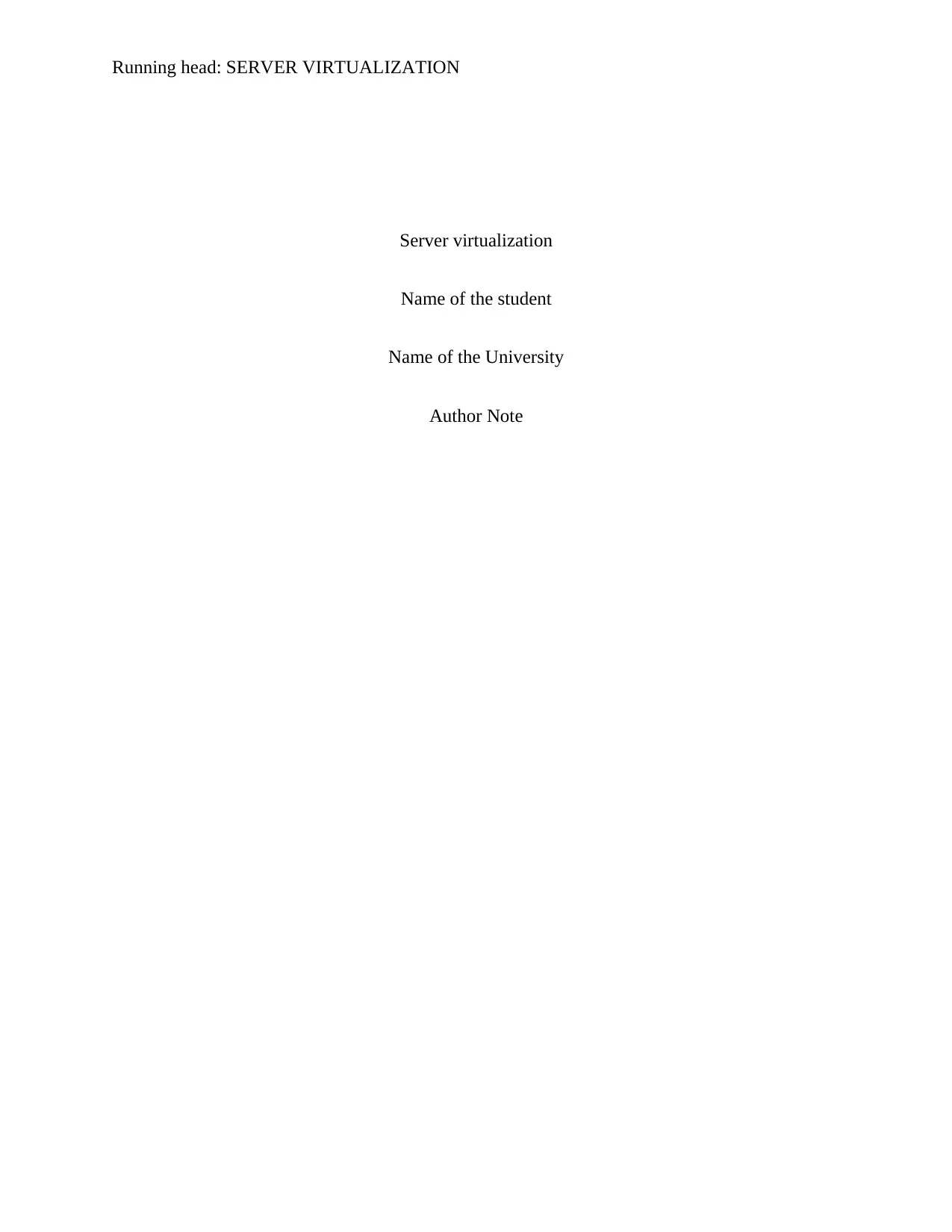
Running head: SERVER VIRTUALIZATION
Server virtualization
Name of the student
Name of the University
Author Note
Server virtualization
Name of the student
Name of the University
Author Note
Paraphrase This Document
Need a fresh take? Get an instant paraphrase of this document with our AI Paraphraser
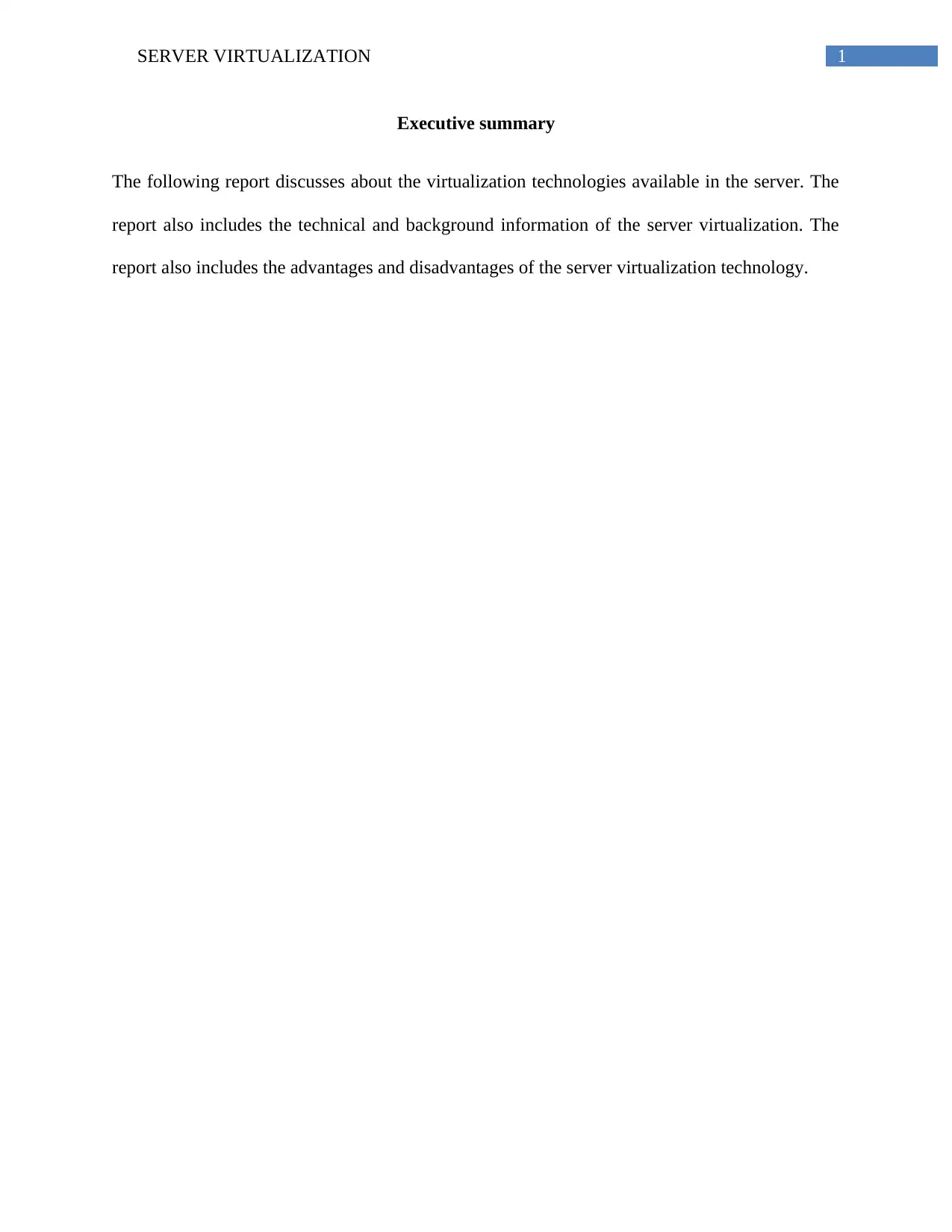
1SERVER VIRTUALIZATION
Executive summary
The following report discusses about the virtualization technologies available in the server. The
report also includes the technical and background information of the server virtualization. The
report also includes the advantages and disadvantages of the server virtualization technology.
Executive summary
The following report discusses about the virtualization technologies available in the server. The
report also includes the technical and background information of the server virtualization. The
report also includes the advantages and disadvantages of the server virtualization technology.
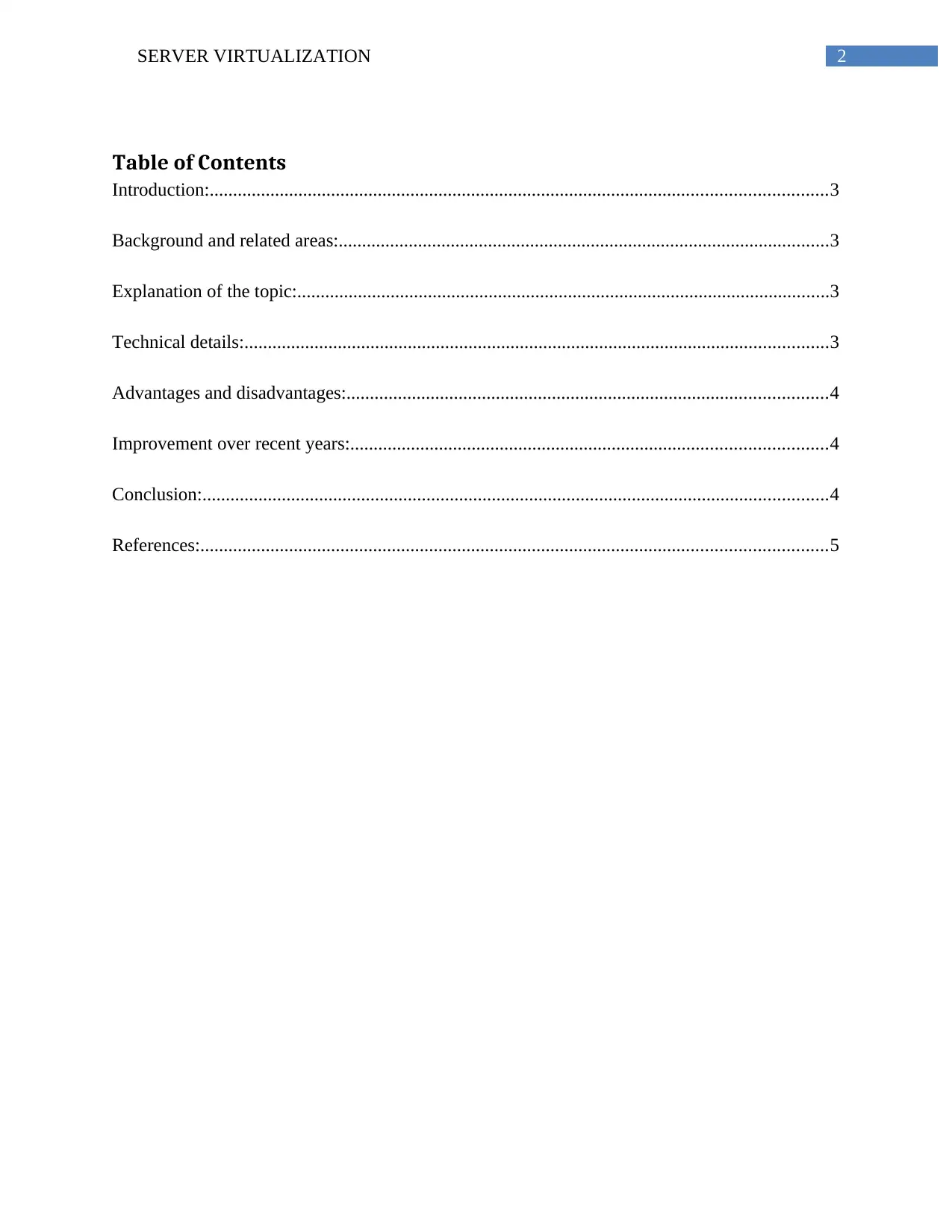
2SERVER VIRTUALIZATION
Table of Contents
Introduction:....................................................................................................................................3
Background and related areas:.........................................................................................................3
Explanation of the topic:..................................................................................................................3
Technical details:.............................................................................................................................3
Advantages and disadvantages:.......................................................................................................4
Improvement over recent years:......................................................................................................4
Conclusion:......................................................................................................................................4
References:......................................................................................................................................5
Table of Contents
Introduction:....................................................................................................................................3
Background and related areas:.........................................................................................................3
Explanation of the topic:..................................................................................................................3
Technical details:.............................................................................................................................3
Advantages and disadvantages:.......................................................................................................4
Improvement over recent years:......................................................................................................4
Conclusion:......................................................................................................................................4
References:......................................................................................................................................5
⊘ This is a preview!⊘
Do you want full access?
Subscribe today to unlock all pages.

Trusted by 1+ million students worldwide
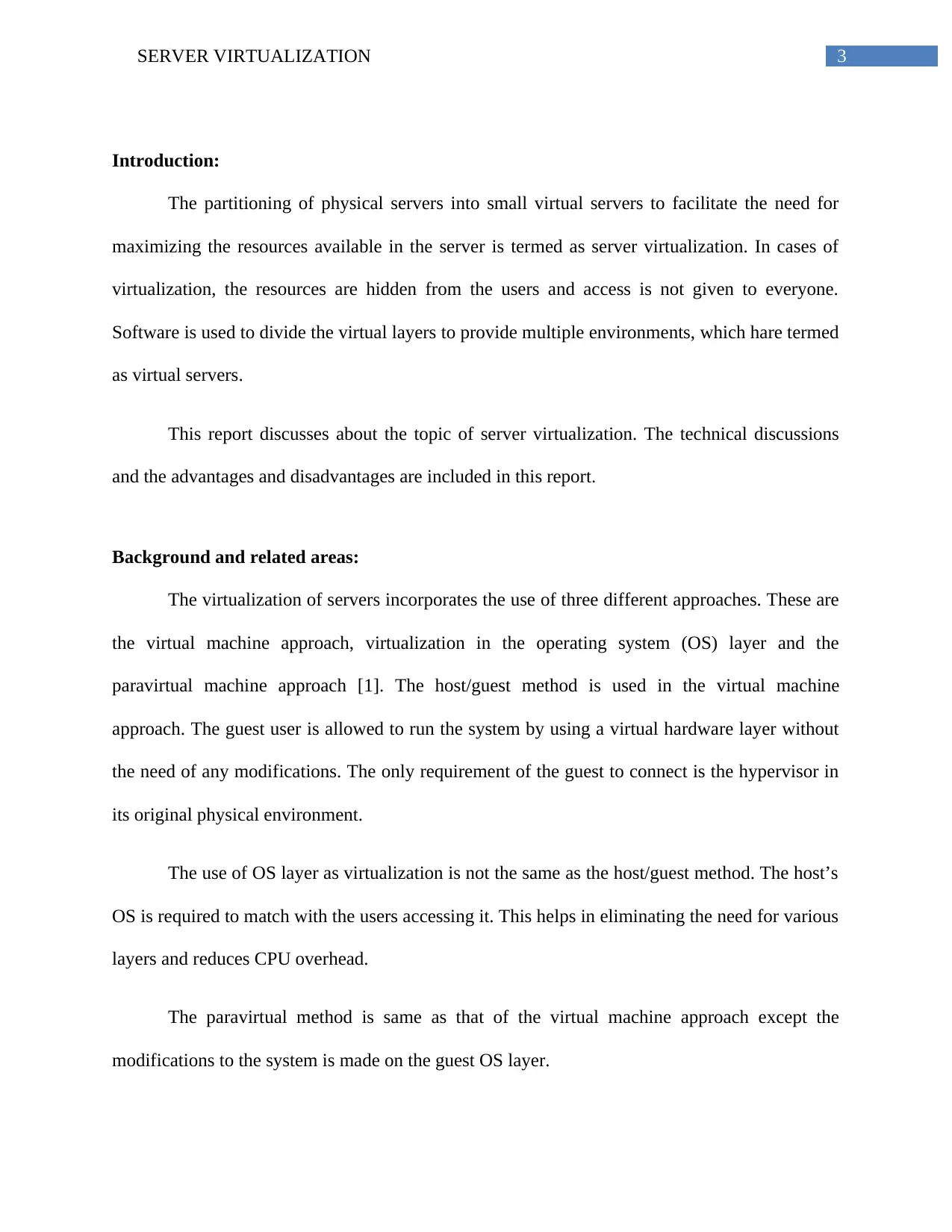
3SERVER VIRTUALIZATION
Introduction:
The partitioning of physical servers into small virtual servers to facilitate the need for
maximizing the resources available in the server is termed as server virtualization. In cases of
virtualization, the resources are hidden from the users and access is not given to everyone.
Software is used to divide the virtual layers to provide multiple environments, which hare termed
as virtual servers.
This report discusses about the topic of server virtualization. The technical discussions
and the advantages and disadvantages are included in this report.
Background and related areas:
The virtualization of servers incorporates the use of three different approaches. These are
the virtual machine approach, virtualization in the operating system (OS) layer and the
paravirtual machine approach [1]. The host/guest method is used in the virtual machine
approach. The guest user is allowed to run the system by using a virtual hardware layer without
the need of any modifications. The only requirement of the guest to connect is the hypervisor in
its original physical environment.
The use of OS layer as virtualization is not the same as the host/guest method. The host’s
OS is required to match with the users accessing it. This helps in eliminating the need for various
layers and reduces CPU overhead.
The paravirtual method is same as that of the virtual machine approach except the
modifications to the system is made on the guest OS layer.
Introduction:
The partitioning of physical servers into small virtual servers to facilitate the need for
maximizing the resources available in the server is termed as server virtualization. In cases of
virtualization, the resources are hidden from the users and access is not given to everyone.
Software is used to divide the virtual layers to provide multiple environments, which hare termed
as virtual servers.
This report discusses about the topic of server virtualization. The technical discussions
and the advantages and disadvantages are included in this report.
Background and related areas:
The virtualization of servers incorporates the use of three different approaches. These are
the virtual machine approach, virtualization in the operating system (OS) layer and the
paravirtual machine approach [1]. The host/guest method is used in the virtual machine
approach. The guest user is allowed to run the system by using a virtual hardware layer without
the need of any modifications. The only requirement of the guest to connect is the hypervisor in
its original physical environment.
The use of OS layer as virtualization is not the same as the host/guest method. The host’s
OS is required to match with the users accessing it. This helps in eliminating the need for various
layers and reduces CPU overhead.
The paravirtual method is same as that of the virtual machine approach except the
modifications to the system is made on the guest OS layer.
Paraphrase This Document
Need a fresh take? Get an instant paraphrase of this document with our AI Paraphraser
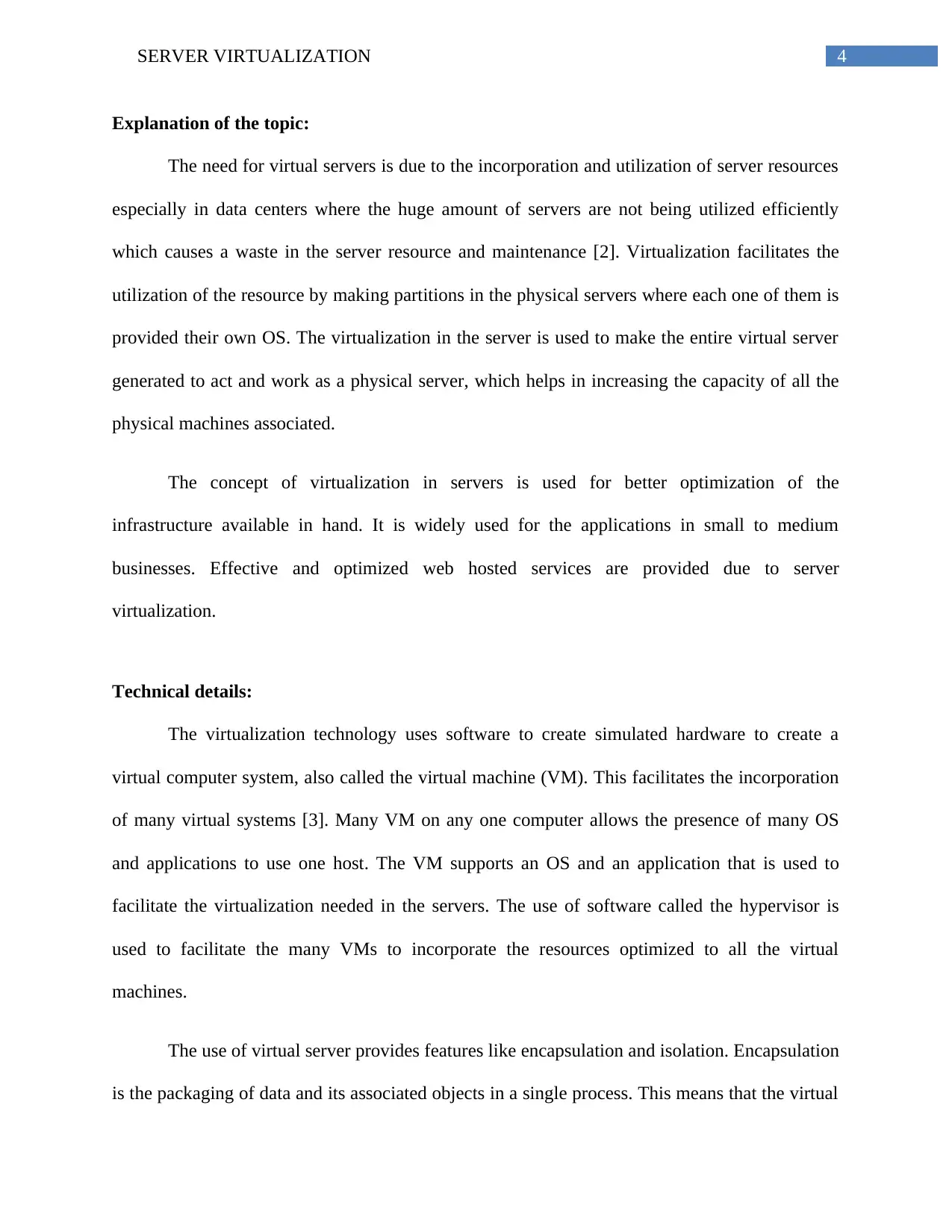
4SERVER VIRTUALIZATION
Explanation of the topic:
The need for virtual servers is due to the incorporation and utilization of server resources
especially in data centers where the huge amount of servers are not being utilized efficiently
which causes a waste in the server resource and maintenance [2]. Virtualization facilitates the
utilization of the resource by making partitions in the physical servers where each one of them is
provided their own OS. The virtualization in the server is used to make the entire virtual server
generated to act and work as a physical server, which helps in increasing the capacity of all the
physical machines associated.
The concept of virtualization in servers is used for better optimization of the
infrastructure available in hand. It is widely used for the applications in small to medium
businesses. Effective and optimized web hosted services are provided due to server
virtualization.
Technical details:
The virtualization technology uses software to create simulated hardware to create a
virtual computer system, also called the virtual machine (VM). This facilitates the incorporation
of many virtual systems [3]. Many VM on any one computer allows the presence of many OS
and applications to use one host. The VM supports an OS and an application that is used to
facilitate the virtualization needed in the servers. The use of software called the hypervisor is
used to facilitate the many VMs to incorporate the resources optimized to all the virtual
machines.
The use of virtual server provides features like encapsulation and isolation. Encapsulation
is the packaging of data and its associated objects in a single process. This means that the virtual
Explanation of the topic:
The need for virtual servers is due to the incorporation and utilization of server resources
especially in data centers where the huge amount of servers are not being utilized efficiently
which causes a waste in the server resource and maintenance [2]. Virtualization facilitates the
utilization of the resource by making partitions in the physical servers where each one of them is
provided their own OS. The virtualization in the server is used to make the entire virtual server
generated to act and work as a physical server, which helps in increasing the capacity of all the
physical machines associated.
The concept of virtualization in servers is used for better optimization of the
infrastructure available in hand. It is widely used for the applications in small to medium
businesses. Effective and optimized web hosted services are provided due to server
virtualization.
Technical details:
The virtualization technology uses software to create simulated hardware to create a
virtual computer system, also called the virtual machine (VM). This facilitates the incorporation
of many virtual systems [3]. Many VM on any one computer allows the presence of many OS
and applications to use one host. The VM supports an OS and an application that is used to
facilitate the virtualization needed in the servers. The use of software called the hypervisor is
used to facilitate the many VMs to incorporate the resources optimized to all the virtual
machines.
The use of virtual server provides features like encapsulation and isolation. Encapsulation
is the packaging of data and its associated objects in a single process. This means that the virtual
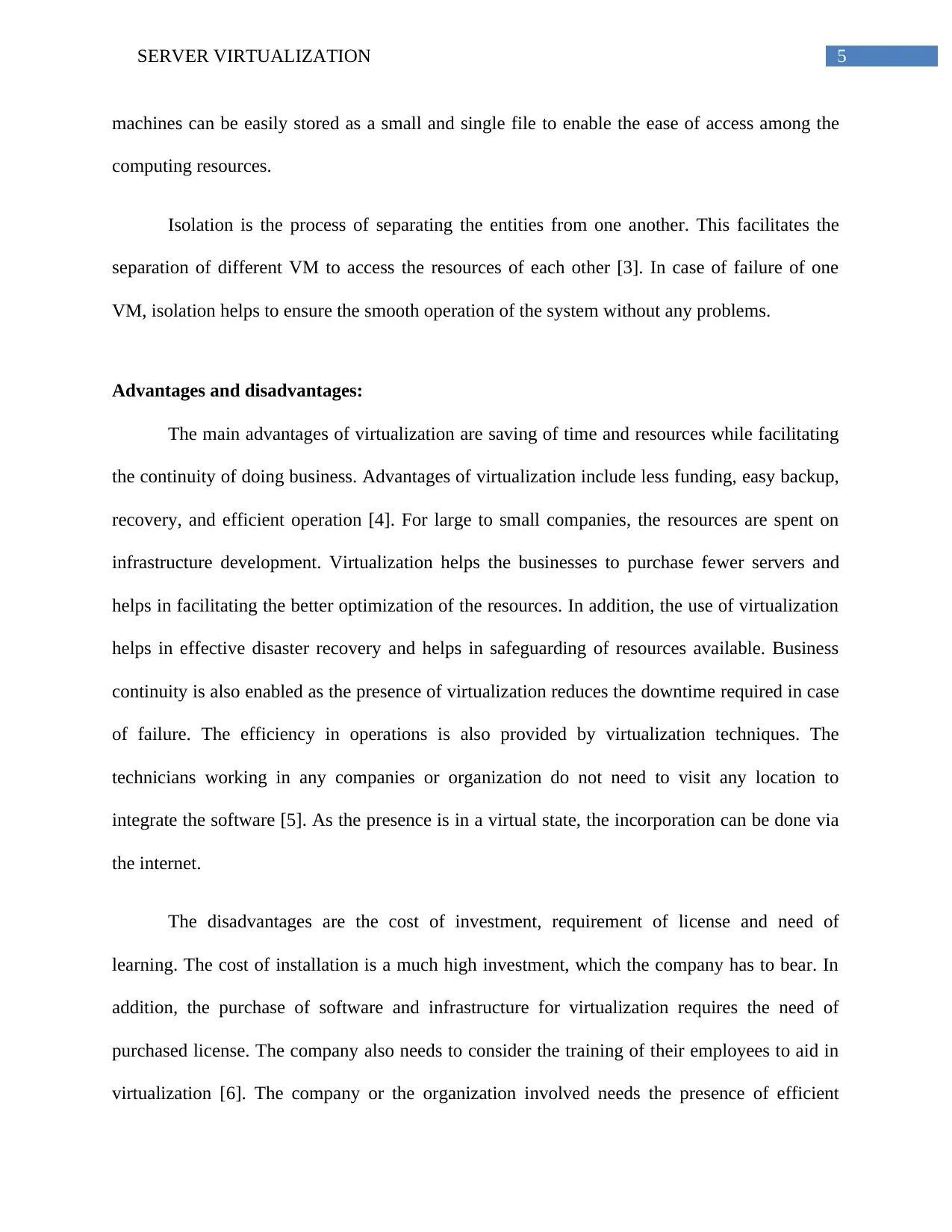
5SERVER VIRTUALIZATION
machines can be easily stored as a small and single file to enable the ease of access among the
computing resources.
Isolation is the process of separating the entities from one another. This facilitates the
separation of different VM to access the resources of each other [3]. In case of failure of one
VM, isolation helps to ensure the smooth operation of the system without any problems.
Advantages and disadvantages:
The main advantages of virtualization are saving of time and resources while facilitating
the continuity of doing business. Advantages of virtualization include less funding, easy backup,
recovery, and efficient operation [4]. For large to small companies, the resources are spent on
infrastructure development. Virtualization helps the businesses to purchase fewer servers and
helps in facilitating the better optimization of the resources. In addition, the use of virtualization
helps in effective disaster recovery and helps in safeguarding of resources available. Business
continuity is also enabled as the presence of virtualization reduces the downtime required in case
of failure. The efficiency in operations is also provided by virtualization techniques. The
technicians working in any companies or organization do not need to visit any location to
integrate the software [5]. As the presence is in a virtual state, the incorporation can be done via
the internet.
The disadvantages are the cost of investment, requirement of license and need of
learning. The cost of installation is a much high investment, which the company has to bear. In
addition, the purchase of software and infrastructure for virtualization requires the need of
purchased license. The company also needs to consider the training of their employees to aid in
virtualization [6]. The company or the organization involved needs the presence of efficient
machines can be easily stored as a small and single file to enable the ease of access among the
computing resources.
Isolation is the process of separating the entities from one another. This facilitates the
separation of different VM to access the resources of each other [3]. In case of failure of one
VM, isolation helps to ensure the smooth operation of the system without any problems.
Advantages and disadvantages:
The main advantages of virtualization are saving of time and resources while facilitating
the continuity of doing business. Advantages of virtualization include less funding, easy backup,
recovery, and efficient operation [4]. For large to small companies, the resources are spent on
infrastructure development. Virtualization helps the businesses to purchase fewer servers and
helps in facilitating the better optimization of the resources. In addition, the use of virtualization
helps in effective disaster recovery and helps in safeguarding of resources available. Business
continuity is also enabled as the presence of virtualization reduces the downtime required in case
of failure. The efficiency in operations is also provided by virtualization techniques. The
technicians working in any companies or organization do not need to visit any location to
integrate the software [5]. As the presence is in a virtual state, the incorporation can be done via
the internet.
The disadvantages are the cost of investment, requirement of license and need of
learning. The cost of installation is a much high investment, which the company has to bear. In
addition, the purchase of software and infrastructure for virtualization requires the need of
purchased license. The company also needs to consider the training of their employees to aid in
virtualization [6]. The company or the organization involved needs the presence of efficient
⊘ This is a preview!⊘
Do you want full access?
Subscribe today to unlock all pages.

Trusted by 1+ million students worldwide
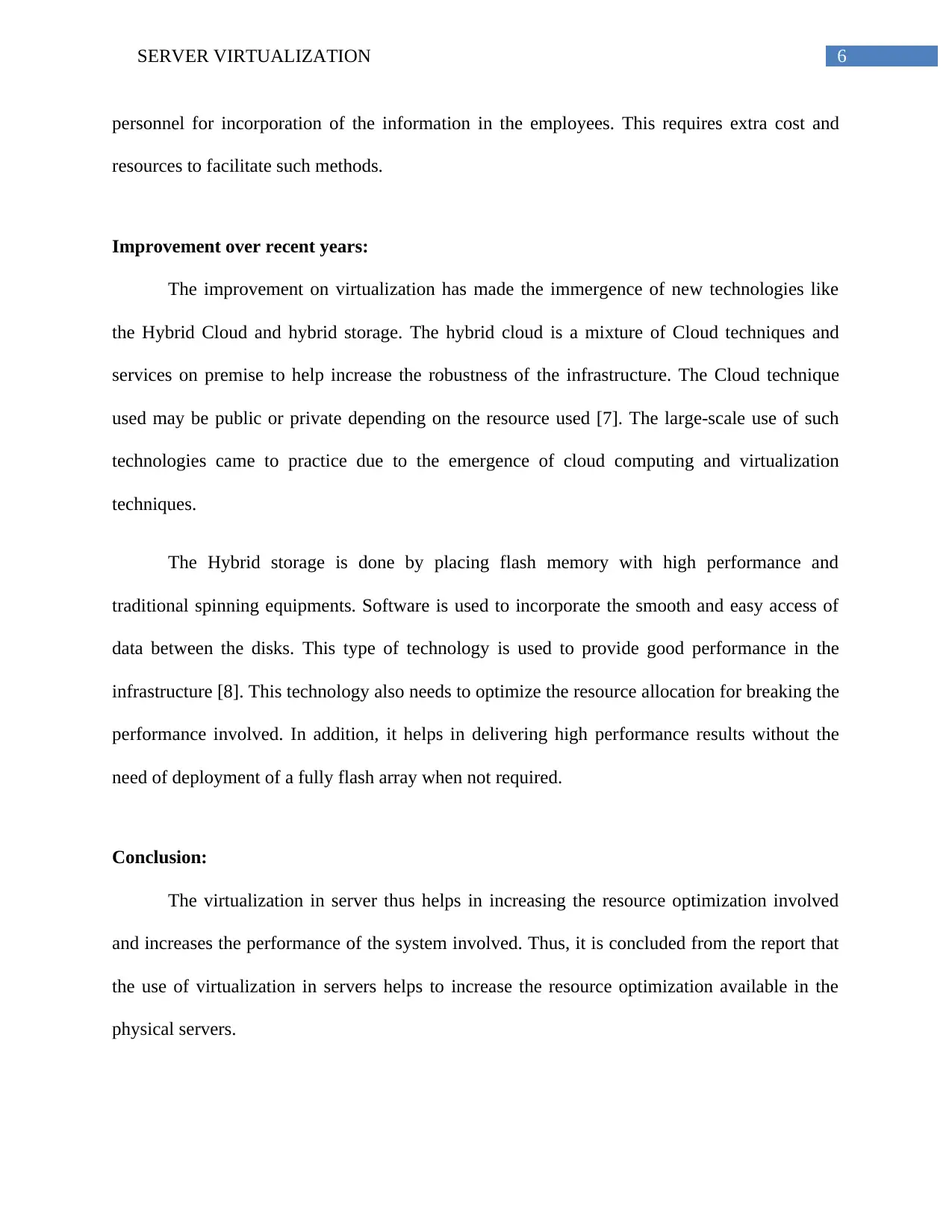
6SERVER VIRTUALIZATION
personnel for incorporation of the information in the employees. This requires extra cost and
resources to facilitate such methods.
Improvement over recent years:
The improvement on virtualization has made the immergence of new technologies like
the Hybrid Cloud and hybrid storage. The hybrid cloud is a mixture of Cloud techniques and
services on premise to help increase the robustness of the infrastructure. The Cloud technique
used may be public or private depending on the resource used [7]. The large-scale use of such
technologies came to practice due to the emergence of cloud computing and virtualization
techniques.
The Hybrid storage is done by placing flash memory with high performance and
traditional spinning equipments. Software is used to incorporate the smooth and easy access of
data between the disks. This type of technology is used to provide good performance in the
infrastructure [8]. This technology also needs to optimize the resource allocation for breaking the
performance involved. In addition, it helps in delivering high performance results without the
need of deployment of a fully flash array when not required.
Conclusion:
The virtualization in server thus helps in increasing the resource optimization involved
and increases the performance of the system involved. Thus, it is concluded from the report that
the use of virtualization in servers helps to increase the resource optimization available in the
physical servers.
personnel for incorporation of the information in the employees. This requires extra cost and
resources to facilitate such methods.
Improvement over recent years:
The improvement on virtualization has made the immergence of new technologies like
the Hybrid Cloud and hybrid storage. The hybrid cloud is a mixture of Cloud techniques and
services on premise to help increase the robustness of the infrastructure. The Cloud technique
used may be public or private depending on the resource used [7]. The large-scale use of such
technologies came to practice due to the emergence of cloud computing and virtualization
techniques.
The Hybrid storage is done by placing flash memory with high performance and
traditional spinning equipments. Software is used to incorporate the smooth and easy access of
data between the disks. This type of technology is used to provide good performance in the
infrastructure [8]. This technology also needs to optimize the resource allocation for breaking the
performance involved. In addition, it helps in delivering high performance results without the
need of deployment of a fully flash array when not required.
Conclusion:
The virtualization in server thus helps in increasing the resource optimization involved
and increases the performance of the system involved. Thus, it is concluded from the report that
the use of virtualization in servers helps to increase the resource optimization available in the
physical servers.
Paraphrase This Document
Need a fresh take? Get an instant paraphrase of this document with our AI Paraphraser
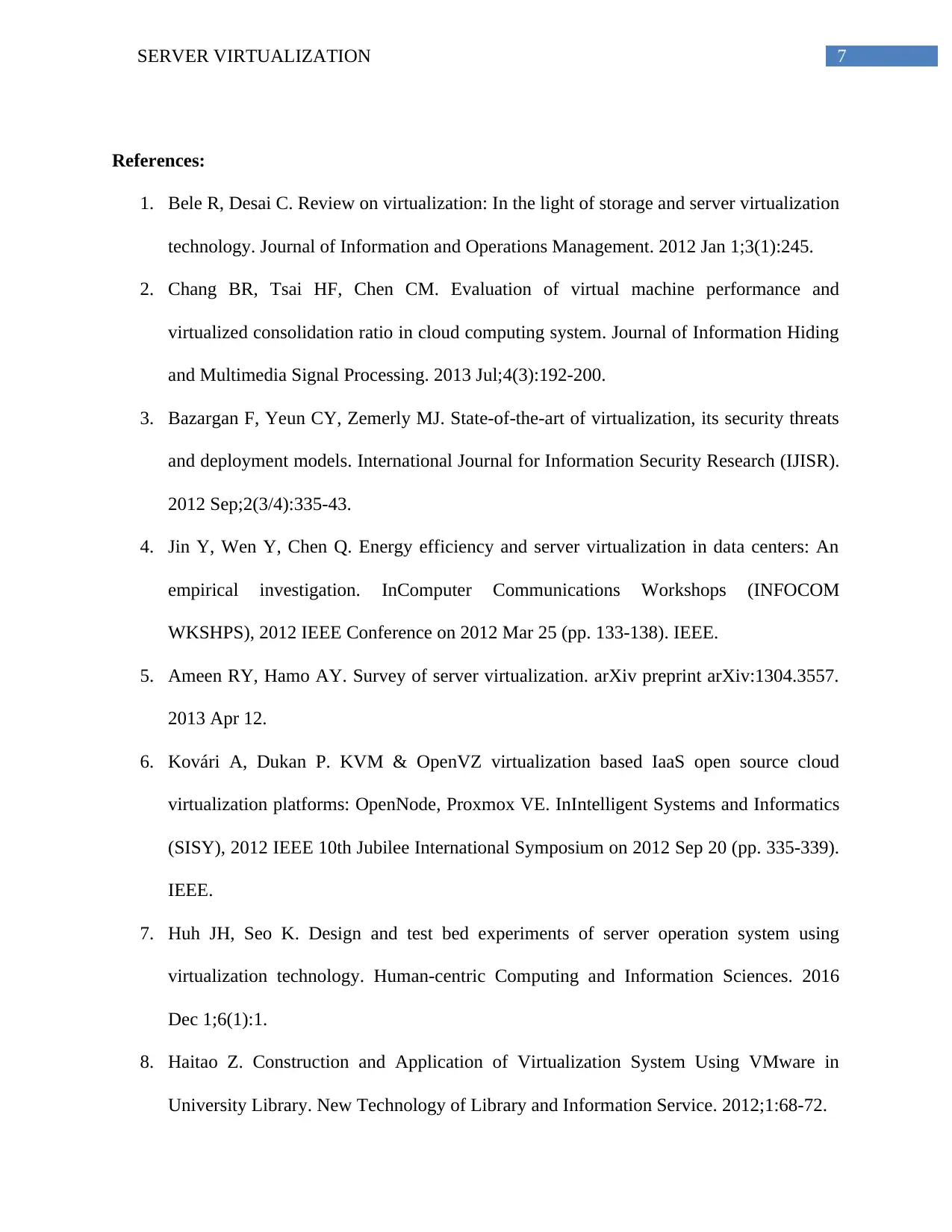
7SERVER VIRTUALIZATION
References:
1. Bele R, Desai C. Review on virtualization: In the light of storage and server virtualization
technology. Journal of Information and Operations Management. 2012 Jan 1;3(1):245.
2. Chang BR, Tsai HF, Chen CM. Evaluation of virtual machine performance and
virtualized consolidation ratio in cloud computing system. Journal of Information Hiding
and Multimedia Signal Processing. 2013 Jul;4(3):192-200.
3. Bazargan F, Yeun CY, Zemerly MJ. State-of-the-art of virtualization, its security threats
and deployment models. International Journal for Information Security Research (IJISR).
2012 Sep;2(3/4):335-43.
4. Jin Y, Wen Y, Chen Q. Energy efficiency and server virtualization in data centers: An
empirical investigation. InComputer Communications Workshops (INFOCOM
WKSHPS), 2012 IEEE Conference on 2012 Mar 25 (pp. 133-138). IEEE.
5. Ameen RY, Hamo AY. Survey of server virtualization. arXiv preprint arXiv:1304.3557.
2013 Apr 12.
6. Kovári A, Dukan P. KVM & OpenVZ virtualization based IaaS open source cloud
virtualization platforms: OpenNode, Proxmox VE. InIntelligent Systems and Informatics
(SISY), 2012 IEEE 10th Jubilee International Symposium on 2012 Sep 20 (pp. 335-339).
IEEE.
7. Huh JH, Seo K. Design and test bed experiments of server operation system using
virtualization technology. Human-centric Computing and Information Sciences. 2016
Dec 1;6(1):1.
8. Haitao Z. Construction and Application of Virtualization System Using VMware in
University Library. New Technology of Library and Information Service. 2012;1:68-72.
References:
1. Bele R, Desai C. Review on virtualization: In the light of storage and server virtualization
technology. Journal of Information and Operations Management. 2012 Jan 1;3(1):245.
2. Chang BR, Tsai HF, Chen CM. Evaluation of virtual machine performance and
virtualized consolidation ratio in cloud computing system. Journal of Information Hiding
and Multimedia Signal Processing. 2013 Jul;4(3):192-200.
3. Bazargan F, Yeun CY, Zemerly MJ. State-of-the-art of virtualization, its security threats
and deployment models. International Journal for Information Security Research (IJISR).
2012 Sep;2(3/4):335-43.
4. Jin Y, Wen Y, Chen Q. Energy efficiency and server virtualization in data centers: An
empirical investigation. InComputer Communications Workshops (INFOCOM
WKSHPS), 2012 IEEE Conference on 2012 Mar 25 (pp. 133-138). IEEE.
5. Ameen RY, Hamo AY. Survey of server virtualization. arXiv preprint arXiv:1304.3557.
2013 Apr 12.
6. Kovári A, Dukan P. KVM & OpenVZ virtualization based IaaS open source cloud
virtualization platforms: OpenNode, Proxmox VE. InIntelligent Systems and Informatics
(SISY), 2012 IEEE 10th Jubilee International Symposium on 2012 Sep 20 (pp. 335-339).
IEEE.
7. Huh JH, Seo K. Design and test bed experiments of server operation system using
virtualization technology. Human-centric Computing and Information Sciences. 2016
Dec 1;6(1):1.
8. Haitao Z. Construction and Application of Virtualization System Using VMware in
University Library. New Technology of Library and Information Service. 2012;1:68-72.

8SERVER VIRTUALIZATION
⊘ This is a preview!⊘
Do you want full access?
Subscribe today to unlock all pages.

Trusted by 1+ million students worldwide
1 out of 9
Related Documents
Your All-in-One AI-Powered Toolkit for Academic Success.
+13062052269
info@desklib.com
Available 24*7 on WhatsApp / Email
![[object Object]](/_next/static/media/star-bottom.7253800d.svg)
Unlock your academic potential
Copyright © 2020–2025 A2Z Services. All Rights Reserved. Developed and managed by ZUCOL.




